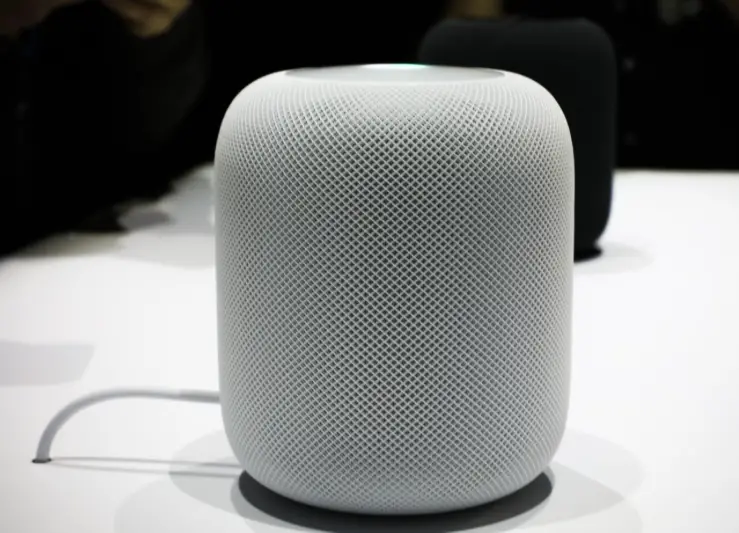Everything You Need To Know About Apple’s HomePod

On February 9th, there’ll be a new player in the smart speaker market, Apple’s HomePod. How does it stack up to other, well-established speakers such as the Amazon Echo? Let’s find out.
It’s Been In Development for Six Years
The HomePod may not roll easily off your tongue with familiarity yet, but Apple’s had it in the works for a long time. Six years, in fact, so the engineering team — comprised of audio specialists and acoustic experts from top universities — is very accustomed to how the HomePod works and feels confident it’s ready for mass release.
There Are Eight Speakers Inside It
At first glance, the HomePod appears to be one speaker. But, looks are deceiving. It has seven beam-forming tweeters and one woofer contained in it. The design of the tweeters means they push certain sounds in different directions, creating a soundscape-like effect. Apple doesn’t refer to the HomePod as a stereo speaker, but when you hear it, it’ll sound distinctively different than a mono version.
Notably, when you’re using all those speakers to hear an audiobook, song or anything else, the product can still pick up on your voice and respond to it.
Giving Voice Commands Should Feel Natural
As you get to know the HomePod, you’ll realize it recognizes “Hey, Siri” commands. So, if you’ve already been using those while speaking to your iPhone, it’ll be easy to start telling the HomePod to do things and start fitting it into your way of life. Also, there are six microphones within it. Rest assured, the HomePod can pick up your voice from across the room.
A High-Tech Sound System
The HomePod also includes the Apple-designed A8 chip, which first appeared in the iPhone 6. It upmixes direct and ambient audio, creating that effect described above that makes this little speaker seem much more massive. The A8 chip also tackles advanced echo cancellation, enhancing the sound quality of everything you hear.
There’s even a continuous algorithm that analyzes the audio output and dynamically changes evens out the low frequencies, making them sound deep but smooth. Plus, when you bring the HomePod into the room, it automatically assesses the room acoustics and adjusts the sound based on the speaker’s location. Early users say judging by sound quality, the HomePod beats Amazon and Google’s smart speakers.
It Could Become Your DJ
Since the HomePod syncs with Apple Music, you can get access to over 45 million songs. The speaker also comes with a three-month trial subscription in case you don’t use the service yet. As you play music through the HomePod, it learns the songs and genres you like most. Although you can ask it to open a certain playlist, the speaker can eventually just pick the music it thinks you’ll like best.
It’s Stylish and Solid
One of the things you may not have heard about the HomePod is how sturdy it looks and feels. The device weighs five-and-a-half pounds, which gives the impression that it’s a well-built product ready for daily use. Also, the outside features fabric-wrapped mesh. You can choose either grey or black for your preferred color.
Even the Display Is Intelligent
Looking at the Apple HomePod for the first time might make you feel taken aback because it doesn’t seem to have buttons. However, once you say the phrase that wakes up the device, notice the swirling display on the top. That section is a touch-sensitive piece that changes in appearance depending on what you say.
Setup Is a Breeze
Maybe the confusing setup process of some smart gadgets is something that makes you resistant to buying any of them. If you’ve had trouble with a setup process before, working with the HomePod for the first time will almost certainly be different. First, make sure you have another Apple device running the latest operating system. Then, hold it near the HomePod.
That’s it. The HomePod senses the other device and uses it to transfer your setting and information from it. The first thing you’ll say to the speaker is, “Hey Siri, what can you do?” It’ll then give you a rundown of some of its functions. The capabilities are not as extensive as what Amazon’s Alexa assistant can do.
In fact, there are a lot of things Siri can’t help you with yet. It’s not possible to make a phone call directly with the HomePod, use it to look up information, or even set two timers at once.
Regarding skills, it’s not as smart as Alexa and mostly excels in sound quality for music and its sleek style. But, if this smart speaker takes off and proves it is indeed a serious competitor to the others already available to buy, expect the list to grow.
Like most consumers, you’re probably thinking, “The features sound great, but how much will this gadget set me back?” It’s $349.00, making it more expensive than the Google Home or any of Amazon’s speakers.
The price point may be a downside if you’re just curious about how Apple made an impact on the smart speaker market. However, if you’re an audiophile, it sounds fantastic for the price — and looks great as it plays your favorite tunes.


